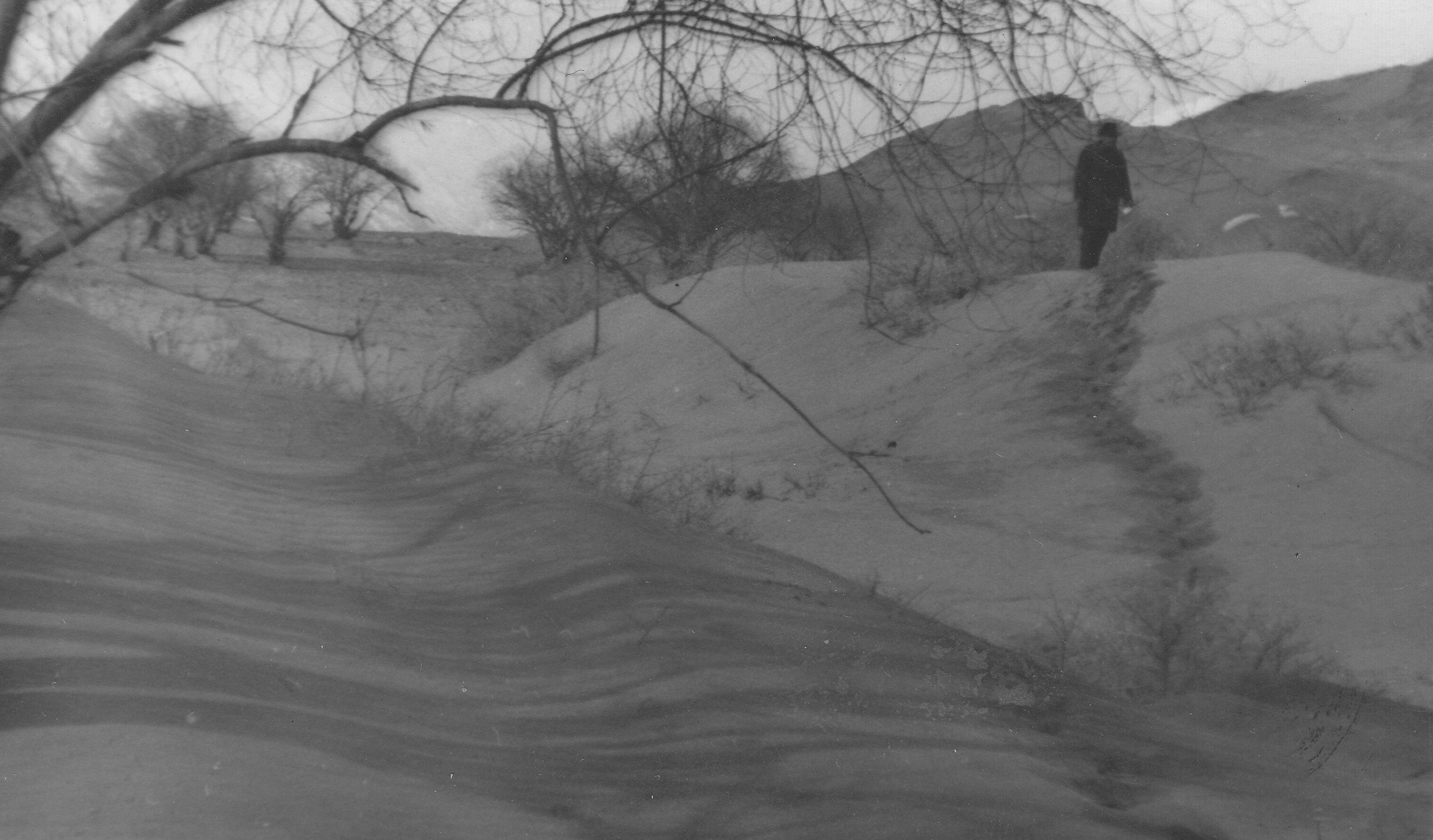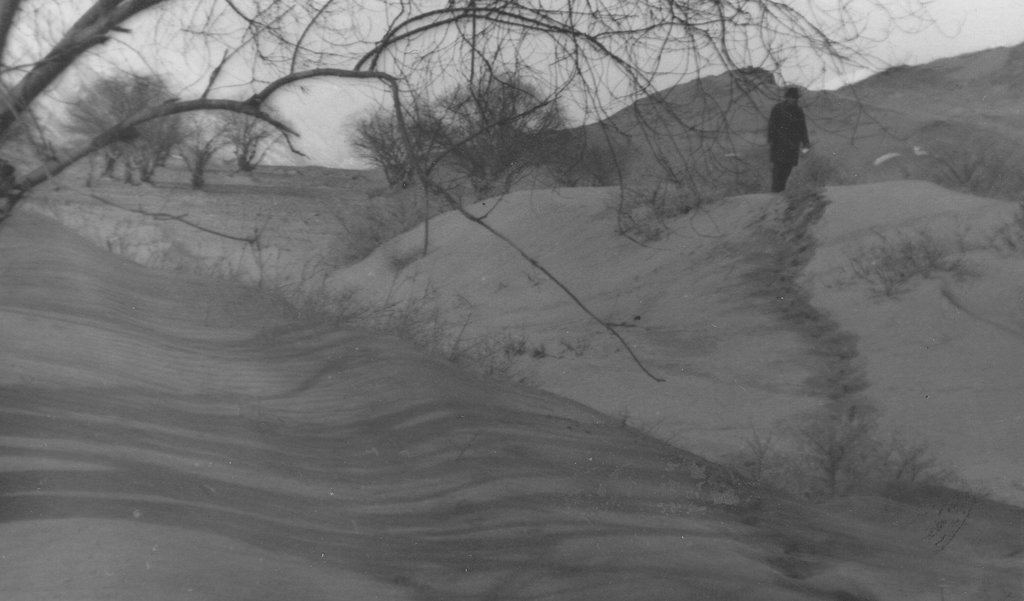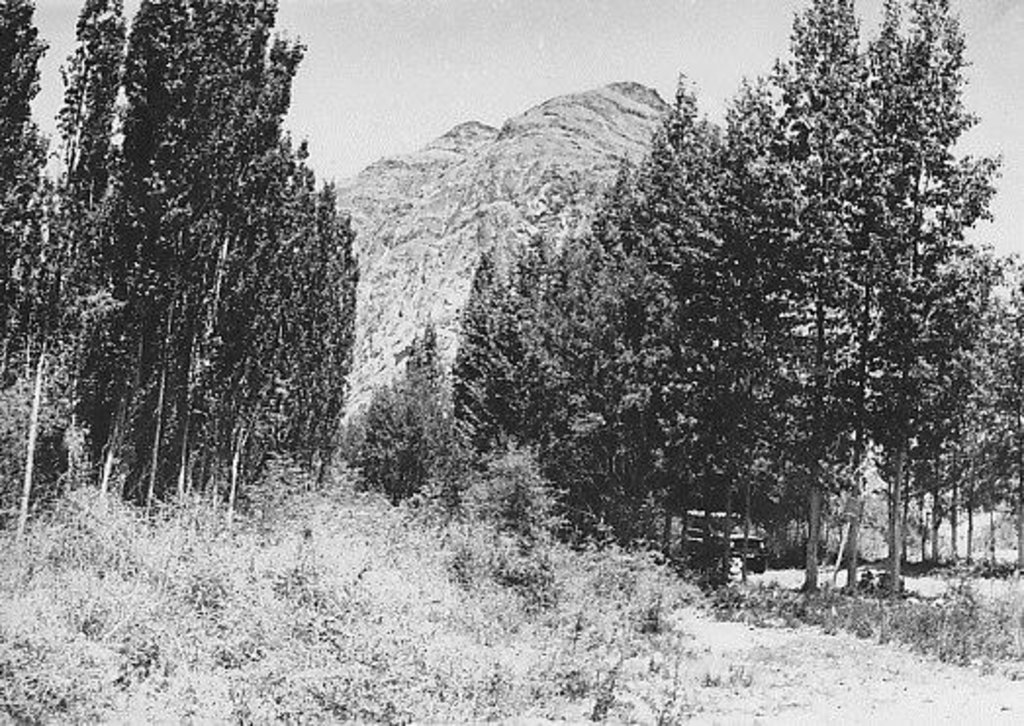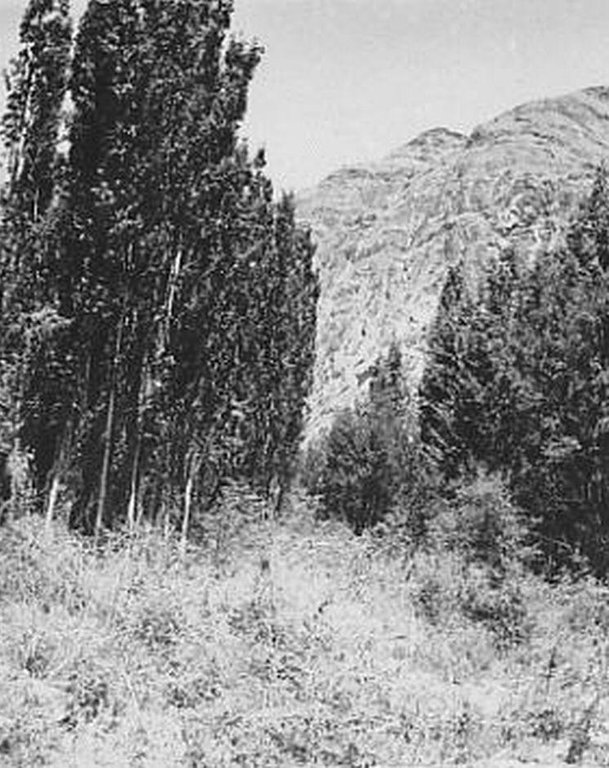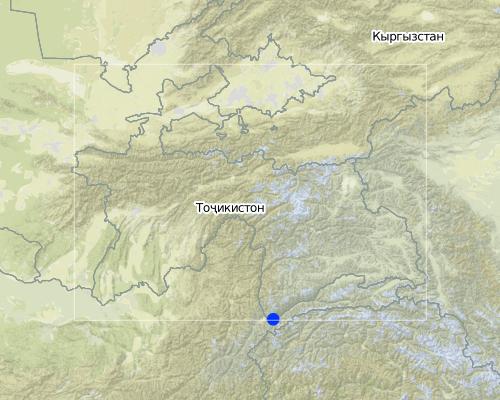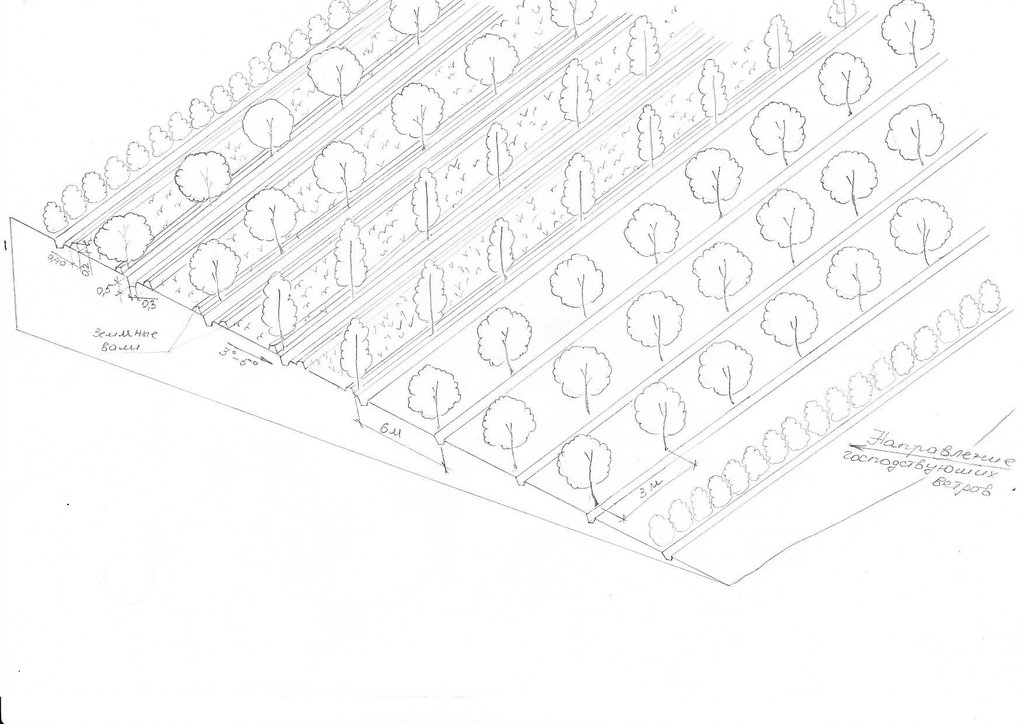Wind forest strips for land protection against wind erosion on sandy soils [塔吉克斯坦]
- 创建:
- 更新:
- 编制者: Aslam Qadamov
- 编辑者: –
- 审查者: David Streiff
technologies_1451 - 塔吉克斯坦
- Wind forest strips for land protection against wind erosion on sandy soils: March 14, 2017 (inactive)
- Wind forest strips for land protection against wind erosion on sandy soils: July 19, 2017 (inactive)
- Wind forest strips for land protection against wind erosion on sandy soils: Aug. 21, 2019 (inactive)
- Wind forest strips for land protection against wind erosion on sandy soils: Nov. 2, 2021 (public)
查看章节
全部展开 全部收起1. 一般信息
1.2 参与该技术评估和文件编制的资源人员和机构的联系方式
SLM专业人员:
Kosumbekov Ahoyatbek
有助于对技术进行记录/评估的机构名称(如相关)
Forestry Department of GBAO - 塔吉克斯坦有助于对技术进行记录/评估的机构名称(如相关)
Pamir Biological Institute (Pamir Biological Institute) - 塔吉克斯坦1.3 关于使用通过WOCAT记录的数据的条件
(现场)数据是什么时候汇编的?:
09/04/2011
编制者和关键资源人员接受有关使用通过WOCAT记录数据的条件。:
是
2. SLM技术的说明
2.1 技术简介
技术定义:
Establishment of an 8-row shelterbelt consisting of different varieties of willow, poplar and sea-buckthorn to protect irrigated cropland with poor quality soil in the high Pamir region from wind erosion.
2.2 技术的详细说明
说明:
The 24m wide shelterbelt consists of eight rows of trees. Three plots, 50m wide and 350m long were left in-between the trees to intercrop with lucerne and other perennial herbs. Thus, the total area which includes the shelterbelts, meadows and irrigation ditches makes up nearly 10 ha. The shelterbelt was established perpendicular to the direction of the strong winds. Past trials have shown that under the harsh climatic conditions of the Pamir region, shelterbelts in sandy and pebbly areas should include at least eight rows of trees and shrubs.
Purpose of the Technology: The purpose of this technology was to intercrop the shelterbelts with lucerne in order to help protect crops from wind erosion.
Establishment / maintenance activities and inputs: Shelterbelts were planted by hand, not using any machinery. Trees and shrubs were planted in accordance with their physiological characteristics and their tolerance to deflation. The eight rows were planted in the following order: 1st row: sea-buckthorn, 2nd: Shugnan willows, 3rd: Thuran willows, 4th: Pamir poplars, 5th: Bolle's poplars, 6th: Wilhelm’s willows, 7th: Shugnan willows and 8th: Sea Buckthorn. The distance between trees in each row was 4m. Willows and poplars were planted as cuttings, around 1.5–3m in length cut off at the point at which the diameter of the base was around 6cm. Sea buckthorn was planted as seeds at a depth of 4-6cm. Horizontal planting, which increases the growth by 25%, was used instead of vertical planting. The trees were planted between late March and early April. Furrow irrigation ditches were dug before the actual planting of the trees. The irrigation ditches were 0.3m deep and 0.5m wide. The plot was then watered before the actual planting of the trees and the Lucerne, to increase the soil moisture and improve the subsequent growth of the trees. Further watering of the area was carried out every 4-7 days depending on the weather conditions and levels of moisture in the soil. These willow and poplar trees can be pruned 5-6 years after the initial planting. At this stage the branches will be 1-3 m long and can be used by the local population.
Natural / human environment: The plot is located in an arid zone which has sandy and pebbly soil with low fertility. Initially this area was covered by Tugai forest and used as grazing land as well as for timber production. However, as a result of deforestation, the land in this area has become highly unstable and poses a threat to the irrigated lands upslope. 80% of the soil consists of stones and sand. Vegetation cover is mainly composed of sagebrush deserts. These shelterbelts were established during Soviet times and when the civil war broke out after independence, many of the poplar trees were cut down by the local population for construction- and firewood. Therefore only parts of the original shelterbelts are still in place today.
2.3 技术照片
2.5 已应用该技术的、本评估所涵盖的国家/地区/地点
国家:
塔吉克斯坦
区域/州/省:
GBAO
有关地点的进一步说明:
Ishkashim
注释:
Boundary points of the Technology area: 36.40.46 - 71.47.28 36.40.37 - 71.47.26 36.4051 - 71.47.01 36.40.36 - 71.47.02
Map
×2.6 实施日期
如果不知道确切的年份,请说明大概的日期:
- 50多年前(传统)
2.7 技术介绍
详细说明该技术是如何引入的:
- 在实验/研究期间
注释(项目类型等):
58 years ago
3. SLM技术的分类
3.1 该技术的主要目的
- 减少、预防、恢复土地退化
3.2 应用该技术的当前土地利用类型

农田
- 一年一作
- 多年一作(非木材)
- 乔木与灌木的种植
主要农作物(经济作物及粮食作物):
major cash crop: potato, alfa alfa, poplar
major food crop: potato, alfa alfa, poplar
other: carrot, onion, cabbage and willow

森林/林地
产品和服务:
- 薪材
- 水果和坚果
- 放牧/啃牧
- 自然保持/保护
- 自然灾害防护
注释:
Major land use problems (compiler’s opinion): land loss, soil fertility decrease, desertification of the area, poverty,
Major land use problems (land users’ perception): land degradation, land fertility decrease, deforestation, poverty
Plantation forestry: Yes
Forest products and services: fuelwood, fruits and nuts, grazing / browsing, nature conservation / protection, protection against natural hazards
Future (final) land use (after implementation of SLM Technology): Forests / woodlands: Fp: Plantations, afforestations
Livestock is grazing on crop residues
如果由于技术的实施而导致土地用途发生变化,则在技术实施前说明土地利的用途。:
Other: Oo: Other: wastelands, deserts, glaciers, swamps, recreation areas, etc
3.3 有关土地利用的更多信息
该技术所应用土地的供水:
- 充分灌溉
每年的生长季节数:
- 1
具体说明:
Longest growing period in days: 150Longest growing period from month to month: from May to September
3.4 该技术所属的SLM组
- 防风林/防护林带
- 改良的地面/植被覆盖
3.5 技术传播
注释:
Total area covered by the SLM Technology is 0.1 m2.
about 10 ha
3.6 包含该技术的可持续土地管理措施

农艺措施
- A1:植被和土壤覆盖层

植物措施
- V1:乔木和灌木覆盖层

结构措施
- S11:其它

管理措施
- M1:改变土地使用类型
注释:
Main measures: vegetative measures
Type of vegetative measures: aligned: -against wind, aligned: -linear
3.7 该技术强调的主要土地退化类型

土壤风蚀
- Ed:风蚀风积
注释:
Main type of degradation addressed: Ed: deflation and deposition
Main causes of degradation: deforestation / removal of natural vegetation (incl. forest fires) (excessive cutting of natural trees and shrubs), wind storms / dust storms (during the wind storm sand covers the cultivated lands), land tenure (more of the forests destroyed in transition period), poverty / wealth (shortage of electricity was the main reason of forest degradation)
Secondary causes of degradation: over-exploitation of vegetation for domestic use (grass was used for livestock), overgrazing (overgrazing of the natural forests by livestock)
3.8 防止、减少或恢复土地退化
具体数量名该技术与土地退化有关的目标:
- 减少土地退化
- 修复/恢复严重退化的土地
注释:
Main goals: prevention of land degradation
Secondary goals: mitigation / reduction of land degradation, rehabilitation / reclamation of denuded land
4. 技术规范、实施活动、投入和成本
4.1 该技术的技术图纸
4.2 技术规范/技术图纸说明
Восьмирядная лесополоса из тополей, ивы и облепихи устраиваеться против направления господствуюших ветров. Первый ряд состоит из облепихи которая очень устойчива к воздействии пыльных бур. В междурядья в тыльной части высеиыается люцерна.
Location: GBAO. Ishkashim
Date: 20.04.2011
Technical knowledge required for field staff / advisors: moderate (All the works are simple for implementaton)
Technical knowledge required for land users: moderate (All the works are simple for implementaton)
Main technical functions: improvement of ground cover, improvement of surface structure (crusting, sealing), improvement of topsoil structure (compaction), stabilisation of soil (eg by tree roots against land slides), increase in nutrient availability (supply, recycling,…), reduction in wind speed, increase of biomass (quantity), promotion of vegetation species and varieties (quality, eg palatable fodder), spatial arrangement and diversification of land use
Secondary technical functions: increase of surface roughness, improvement of subsoil structure (hardpan), increase in organic matter, increase of infiltration, increase / maintain water stored in soil, increase of groundwater level / recharge of groundwater
Aligned: -against wind
Vegetative material: T : trees / shrubs
Number of plants per (ha): 390
Vertical interval between rows / strips / blocks (m): 1
Spacing between rows / strips / blocks (m): 6
Vertical interval within rows / strips / blocks (m): 3
Aligned: -linear
Vegetative material: G : grass
Number of plants per (ha): 20 kg seeds
Width within rows / strips / blocks (m): 4
Trees/ shrubs species: sea-buckthorns, willows and poplars
Perennial crops species: alfa alfa
Grass species: alfa alfa
Slope (which determines the spacing indicated above): 0.00%
If the original slope has changed as a result of the Technology, the slope today is (see figure below): 0.00%
Gradient along the rows / strips: 0.20%
4.3 有关投入和成本计算的一般信息
具体说明成本计算所用货币:
- 美元
注明雇用劳工的每日平均工资成本:
3.00
4.4 技术建立活动
| 活动 | 措施类型 | 时间 | |
|---|---|---|---|
| 1. | digging of pits for tree planting | 植物性的 | first year |
| 2. | planting of trees | 植物性的 | first year |
| 3. | sowing of the alfa-alfa in drills | 植物性的 | every 5 years |
| 4. | construction of irrigation canals | 植物性的 |
4.5 技术建立所需要的费用和投入
| 对投入进行具体说明 | 单位 | 数量 | 单位成本 | 每项投入的总成本 | 土地使用者承担的成本% | |
|---|---|---|---|---|---|---|
| 劳动力 | Digging of pits for tree | Persons/day | 10.0 | 18.0 | 180.0 | 100.0 |
| 劳动力 | Planting of trees | Persons/day | 10.0 | 10.0 | 100.0 | 100.0 |
| 劳动力 | Sowing of the alfa-alfa in drills | Persons/day | 8.0 | 3.125 | 25.0 | 100.0 |
| 劳动力 | Construction of irrigation canals | Persons/day | 15.0 | 15.0 | 225.0 | 100.0 |
| 设备 | Shovels and other tools | pieces | 30.0 | 1.0 | 30.0 | |
| 植物材料 | Seedling | pieces | 400.0 | 0.11 | 44.0 | |
| 植物材料 | Alfalfa sees | kg | 20.0 | 0.65 | 13.0 | |
| 肥料和杀菌剂 | Fertilizer | kg | 45.0 | 2.244444 | 101.0 | |
| 技术建立所需总成本 | 718.0 | |||||
注释:
Duration of establishment phase: 1 month(s)
4.6 维护/经常性活动
| 活动 | 措施类型 | 时间/频率 | |
|---|---|---|---|
| 1. | sanitary cutting and pruning | 植物性的 | every year |
| 2. | cutting of alfa alfa | 植物性的 | three times per year |
| 3. | maintenance of the irrigation system | 植物性的 | every year |
4.7 维护/经常性活动所需要的费用和投入(每年)
| 对投入进行具体说明 | 单位 | 数量 | 单位成本 | 每项投入的总成本 | 土地使用者承担的成本% | |
|---|---|---|---|---|---|---|
| 劳动力 | Sanitary cutting and pruning | Persons/day | 3.0 | 3.333 | 10.0 | 100.0 |
| 劳动力 | Cutting of alfa alfa | Persons/day | 5.0 | 12.0 | 60.0 | 100.0 |
| 劳动力 | Maintenance of the irrigation system | Persons/day | 2.0 | 22.5 | 45.0 | 100.0 |
| 设备 | Scissors | pieces | 3.0 | 10.0 | 30.0 | |
| 设备 | Tools | pieces | 7.0 | 1.0 | 7.0 | |
| 技术维护所需总成本 | 152.0 | |||||
注释:
wind breakes and grass strips
4.8 影响成本的最重要因素
描述影响成本的最决定性因素:
seeds and seedlings cost
5. 自然和人文环境
5.1 气候
年降雨量
- < 250毫米
- 251-500毫米
- 501-750毫米
- 751-1,000毫米
- 1,001-1,500毫米
- 1,501-2,000毫米
- 2,001-3,000毫米
- 3,001-4,000毫米
- > 4,000毫米
有关降雨的规范/注释:
average annual rainfall - 110 mm, during winter - spring times, 5 - 6 month of dry time
农业气候带
- 干旱
Thermal climate class: boreal. 3 months below 5°C and 6 months above 5°C
5.2 地形
平均坡度:
- 水平(0-2%)
- 缓降(3-5%)
- 平缓(6-10%)
- 滚坡(11-15%)
- 崎岖(16-30%)
- 陡峭(31-60%)
- 非常陡峭(>60%)
地形:
- 高原/平原
- 山脊
- 山坡
- 山地斜坡
- 麓坡
- 谷底
垂直分布带:
- 0-100 m a.s.l.
- 101-500 m a.s.l.
- 501-1,000 m a.s.l.
- 1,001-1,500 m a.s.l.
- 1,501-2,000 m a.s.l.
- 2,001-2,500 m a.s.l.
- 2,501-3,000 m a.s.l.
- 3,001-4,000 m a.s.l.
- > 4,000 m a.s.l.
关于地形的注释和进一步规范:
Altitudinal zone is 2600 m
Slopes on average are 10 - 14°
5.3 土壤
平均土层深度:
- 非常浅(0-20厘米)
- 浅(21-50厘米)
- 中等深度(51-80厘米)
- 深(81-120厘米)
- 非常深(> 120厘米)
土壤质地(表土):
- 中粒(壤土、粉土)
表土有机质:
- 低(<1%)
如有可能,附上完整的土壤描述或具体说明可用的信息,例如土壤类型、土壤酸碱度、阳离子交换能力、氮、盐度等。:
Soil texture consists of about 70% of sand and 30% of clay
Soil fertility is low, with humus about 0.2 - 0.3 %
Soil drainage / infiltration is medium and during the summer time soil waters rise up to 1m from top soil
Soil water storage capacity is low because of the sandy soil
5.4 水资源可用性和质量
地下水位表:
< 5米
地表水的可用性:
好
水质(未处理):
良好饮用水
关于水质和水量的注释和进一步规范:
Availability of surface water also medium, but good water availibility during vegetation time
Water quality (untreated) is good because water comes from glaciers
5.5 生物多样性
物种多样性:
- 中等
5.6 应用该技术的土地使用者的特征
生产系统的市场定位:
- 混合(生计/商业
非农收入:
- 低于全部收入的10%
相对财富水平:
- 非常贫瘠
- 贫瘠
个人或集体:
- 团体/社区
机械化水平:
- 畜力牵引
- 机械化/电动
性别:
- 女人
- 男人
说明土地使用者的其他有关特征:
Land users applying the Technology are mainly common / average land users
Population density: < 10 persons/km2
Annual population growth: 0.5% - 1%
10% of the land users are average wealthy and own 5% of the land.
60% of the land users are poor and own 70% of the land.
30% of the land users are poor and own 25% of the land.
Market orientation of production system: Products are for subsistence needs mainly but for sale as well
Level of mechanization: Animal traction is available fro most landusers, but machines only for some landusers.
5.7 应用该技术的土地使用者拥有或租用的平均土地面积
- < 0.5 公顷
- 0.5-1 公顷
- 1-2 公顷
- 2-5公顷
- 5-15公顷
- 15-50公顷
- 50-100公顷
- 100-500公顷
- 500-1,000公顷
- 1,000-10,000公顷
- > 10,000公顷
这被认为是小规模、中规模还是大规模的(参照当地实际情况)?:
- 小规模的
注释:
< 0.5 ha for forests.
Average land size is 1.5 ha
5.8 土地所有权、土地使用权和水使用权
土地所有权:
- 州
土地使用权:
- 个人
5.9 进入服务和基础设施的通道
健康:
- 贫瘠
- 适度的
- 好
教育:
- 贫瘠
- 适度的
- 好
技术援助:
- 贫瘠
- 适度的
- 好
就业(例如非农):
- 贫瘠
- 适度的
- 好
市场:
- 贫瘠
- 适度的
- 好
能源:
- 贫瘠
- 适度的
- 好
道路和交通:
- 贫瘠
- 适度的
- 好
饮用水和卫生设施:
- 贫瘠
- 适度的
- 好
金融服务:
- 贫瘠
- 适度的
- 好
6. 影响和结论性说明
6.1 该技术的现场影响
社会经济效应
生产
作物生产
饲料生产
木材生产
生产故障风险
产品多样性
生产区域
土地管理
收入和成本
农业投入费用
注释/具体说明:
irrigation canals are protected and therefore don't have to be cleaned from sediments every year
农业收入
收入来源的多样性
工作量
社会文化影响
食品安全/自给自足
SLM之前的数量:
0%
SLM之后的数量:
80%
注释/具体说明:
technology increases yield from croplands
社区机构
国家机构
SLM/土地退化知识
SLM之前的数量:
0%
SLM之后的数量:
50%
注释/具体说明:
during field work farmers acquire knowledges about erosion and methods to prevent it
社会经济弱势群体的情况
SLM之前的数量:
0%
SLM之后的数量:
50%
注释/具体说明:
poor farmers get opportunity to use more croplands
Livelihoods and human well-being
注释/具体说明:
Because of increased knowledge of the local farmers about erosion, reduce wind storm related diseases
生态影响
水循环/径流
地表径流
地下水位/含水层
蒸发
SLM之前的数量:
0%
SLM之后的数量:
50%
土壤
土壤水分
SLM之前的数量:
0%
SLM之后的数量:
20%
注释/具体说明:
windbreak rows conserve soil moisture
土壤覆盖层
土壤流失
土壤结壳/密封
土壤压实
养分循环/补给
土壤有机物/地下C
生物多样性:植被、动物
生物量/地上C
植物多样性
动物多样性
有益物种
栖息地多样性
减少气候和灾害风险
碳和温室气体的排放
风速
6.2 该技术的场外影响已经显现
风力搬运沉积物
SLM之前的数量:
100%
SLM之后的数量:
20%
对公共/私人基础设施的破坏
SLM之前的数量:
100%
SLM之后的数量:
20%
6.3 技术对渐变气候以及与气候相关的极端情况/灾害的暴露和敏感性(土地使用者认为的极端情况/灾害)
渐变气候
渐变气候
| 季节 | 气候变化/极端天气的类型 | 该技术是如何应对的? | |
|---|---|---|---|
| 年温度 | 增加 | 好 |
气候有关的极端情况(灾害)
气象灾害
| 该技术是如何应对的? | |
|---|---|
| 局地暴雨 | 好 |
| 局地风暴 | 好 |
气候灾害
| 该技术是如何应对的? | |
|---|---|
| 干旱 | 不好 |
水文灾害
| 该技术是如何应对的? | |
|---|---|
| 比较和缓的(河道)洪水 | 不好 |
其他气候相关的后果
其他气候相关的后果
| 该技术是如何应对的? | |
|---|---|
| 缩短生长期 | 好 |
注释:
No, drought is only a problem if it lasts longterm (for a year or more)
6.4 成本效益分析
技术收益与技术建立成本相比如何(从土地使用者的角度看)?
短期回报:
稍微积极
长期回报:
非常积极
技术收益与技术维护成本/经常性成本相比如何(从土地使用者的角度看)?
短期回报:
稍微积极
长期回报:
非常积极
6.5 技术采用
- 大于 50%
如若可行,进行量化(住户数量和/或覆盖面积):
81 Households
在所有采用这项技术的人当中,有多少人是自发地采用该技术,即未获得任何物质奖励/付款?:
- 0-10%
注释:
100% of land user families have adopted the Technology with external material support
81 land user families have adopted the Technology with external material support
There is a little trend towards spontaneous adoption of the Technology
Comments on adoption trend: unfortunately, after the collapse of the Soviet Union and during the civil war people cut down all the shelterbelts for fuelwood, some people have starte to rehabilitate the shelterbelts as they understand their importance, but it is difficult because there is no material support
6.7 该技术的优点/长处/机会
| 编制者或其他关键资源人员认为的长处/优势/机会 |
|---|
| Low cost of the technology as compared to other technologies |
| The use of local sorts of trees and shrubs allows to apply this technology in any climatic zone of the Pamir |
| High tolerance of selected sorts of trees and shrubs to sand storms, which has been confirmed by multiple practical surveys |
6.8 技术的弱点/缺点/风险及其克服方法
| 土地使用者认为的弱点/缺点/风险 | 如何克服它们? |
|---|---|
| Willows and poplar trees are prone to various diseases | use herbicides |
| 编制者或其他关键资源人员认为的弱点/缺点/风险 | 如何克服它们? |
|---|---|
| Forest strips need irrigation | construction of irrigation system |
| Willows and poplar trees are prone to various diseases | use herbicides |
链接和模块
全部展开 全部收起链接
无链接
模块
无模块


